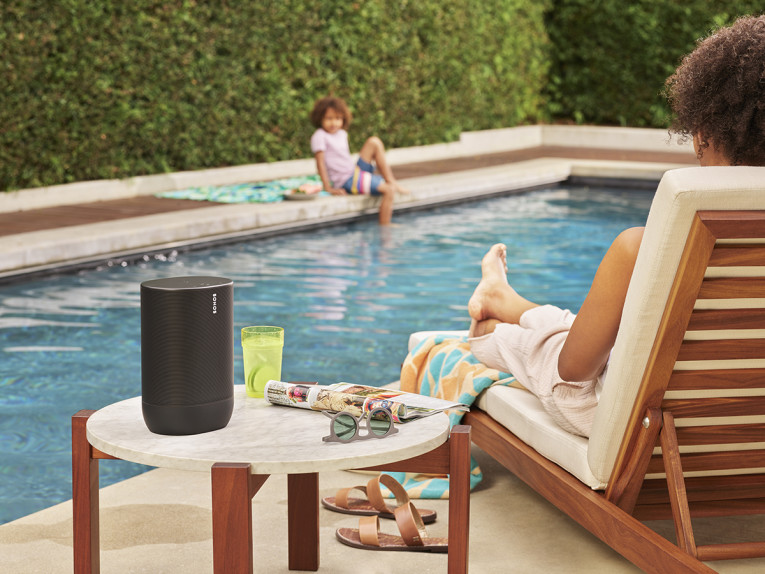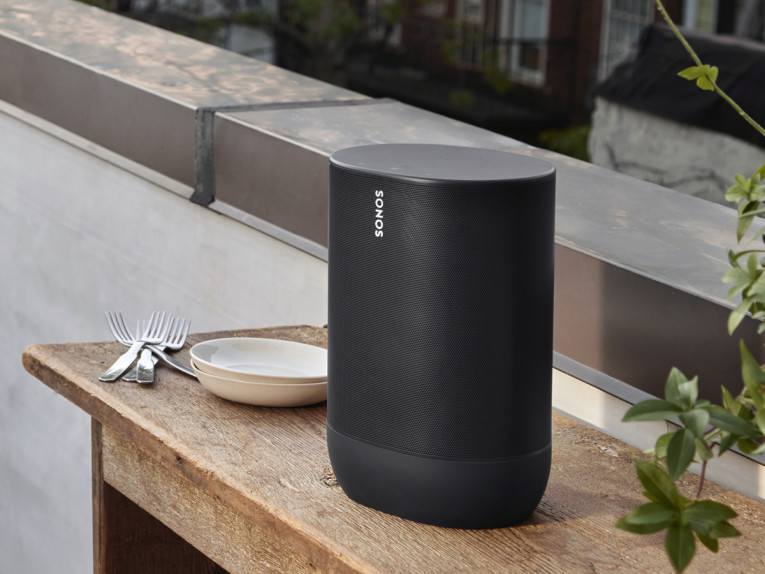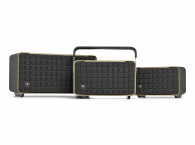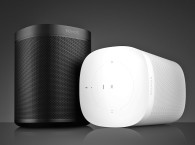
As the name implies, the Move allows taking sound from home to the patio, garden, the neighbours party, or out in the desert (assuming you don’t want to bother other people with your music blasting on a speaker…). Still, the Move is a full part of the Sonos whole-home audio system on WiFi with the added range of Bluetooth, and a powerful design that the brand says, “resets the bar for portable speakers.” Available from September 24 for $399 US.
A big part of the convenience of wireless audio is the fact that there are no wires. Sounds obvious, but the reality is, there’s always a trade-off, as consumers are learning. In the case of the typical Sonos speakers designs, the advantage is to create a complete multi-room sound system at home, with a great sound and the convenience of being able to access any music at any time, in any of the preferred streaming services or local sound sources. Home is full of AC plugs, so the speakers can just stay on all the time and they simply connect to each other wirelessly. But what if we would like to take the music with us to a balcony or a patio where there’s no plug? That’s when we need a battery-operated speaker that is also connected to the wireless network. That is, within the reach of your home WiFi.
So, what happens when you are going on holidays and you still want to take your home Sonos experience with you? That’s what the Sonos Move is intended for. Remember, you still need to charge the battery, and you still need to be connected to WiFi. Of course, the first concern is that the battery-operated design works as well as the other Sonos speakers at home. And that was the focus for Sonos, making sure that Move would be a powerful, versatile smart speaker that sounds incredible indoors, outdoors, and on the go (the on the go part needs further explaining).
“Move represents the best of the Sonos software platform and ecosystem of partners, and supports more than a hundred streaming services, multiple voice assistants, AirPlay2, and more. Available globally this September, Move is one of three new products from Sonos launching this fall, joined by Sonos Port and Sonos One SL, further building on the company’s smart system of speakers and components that prioritizes choice for customers,” the company states in the announcement.

“Since the very beginning, Sonos has been giving listeners unparalleled freedom of choice. Our platform gives you the freedom to play any song you want, any way you want,” says Patrick Spence, CEO, Sonos. “Move takes freedom of choice to the next level. For the first time, you can take Sonos anywhere. Move marks the beginning of a new era for Sonos — one where brilliant sound not only fills your home, but extends to every part of your day.”
No, Sonos is not talking about headphones. Because that’s the product that “extends to every part of your day” allowing anyone to create their own music soundtrack, anywhere without bothering the others. Now, if anyone would just carry a Sonos speaker into the supermarket, or dozens of company employees would decide to go to work always carrying their Sonos Move, each one blasting their own favourite music, that would be simply not acceptable. What Sonos means, is that you can take the Move from the living room to your pool area, or from the home to the garden, and still have your music close during the time the battery lasts. And that’s why the Move was designed with a practical recessed handle on the back. Not exactly to carry with you on an Everest climbing, but good enough to carry a few yards.

“Move resets the bar from what you’d expect from a portable speaker with smart, adaptable sound, surprisingly deep bass and a wide sound profile. Perfectly suited for indoor listening and powerful sound on the go, Move is two smart speakers in one. Featuring powerful wireless range, Move is a full part of the Sonos system, even at the furthest corners of the yard. When away from home, Move is Sonos’ first product with Bluetooth audio streaming making it simple to play audio directly from a phone or tablet to Move for great sound on the go,” Sonos explains.
So, basically, when you are away from home and you have no WiFi connection, your smartphone sends the music via Bluetooth to the Sonos Move, wirelessly - like any other Bluetooth speaker. The difference is that the Move is a smart speaker, and to ensure that it still sounds great anywhere it will go, both indoors and outdoors, Sonos expanded its Trueplay tuning technology with the introduction of automatic Trueplay where the speaker tunes itself to perfectly balance the sound for the environment.
The Move features a sleek oval shadow-black design with an IP56 rating. Sonos took product quality testing to new levels, making sure its premium design would withstand falls, bumps, rain and moisture, dust and dirt, UV and extreme temperatures. And the Move’s battery allows for up to ten hours of continuous play time on a single charge.
While at home, Move easily slides on and off the included indoor charging base to connect every time, ensuring it is always ready for listening. Suspend mode, enabled automatically when not in use or by tapping the power button, reserves the battery for up to five days.
And then there’s the voice recognition part. As the first company to support both leading voice assistants, like in other voice-enabled Sonos devices, the Google Assistant and Amazon Alexa are built right in the Move. While connected to WiFi, users can leverage Sonos’ platform and connect to more than 100 streaming services - music, audiobooks, podcasts and more - and control everything via the Sonos App, with AirPlay 2, or direct from music service apps. Get out of home and the WiFi range, and all the services will depend upon what we have available on the smartphone, via Bluetooth.
Sonos One SL
Meanwhile, further reinforcing Sonos’ commitment to choice, the Santa Barbara-, California based company introduced also the One SL, a speaker that delivers room-filling sound like the compact Sonos One, using two latest-generation Class-D amplifiers, and using no built-in microphones - for those who care about privacy, or simply live in a country that speaks any language other than English, basically the one supported by Alexa and Google Assistant voice recognition services.

A smart speaker without integrated voice assistants, One SL is a full member of the Sonos sound system, with all the same exact features controlled with the Sonos App, already supporting Apple AirPlay2. The fact that it doesn’t have microphones, unfortunately means also that with will not self-adjust to different acoustic environments, and sound needs to be manually adjusted by the user. Oh, wait! But Sonos says that the One SL features “the original Sonos Trueplay tuning technology that optimizes the sound for any room.” So, no auto Trueplay, because there are no microphones anyway, but users can adjust the sound from the app on the smartphone.
In terms of connectivity, the new One SL can be paired with existing Sonos One or another One SL in the same room for stereo separation and more detailed sound - or used in a pair as rear home theater surrounds with Playbar, Playbase, or Beam. The new One SL replaces Play:1 and is available globally starting September 12 for $179, available in all-black and all-white.
Sonos Port
Finally, Sonos introduced the Sonos Port, another wired to wireless interface solution allowing the integration of any stereo or receiver source at home with the Sonos wireless network. The successor to the original Connect, according to Sonos, Port delivers richer sound because it uses updated digital-to-analog conversion. Designed also with the professional installer community in mind, the Port features a versatile design and matte black finish to seamlessly fit on a shelf or stacked in an AV rack. For ease of use, the interface includes a 12V trigger, which automatically turns on an amplifier when signaled from the Sonos app, and provides compatibility with AirPlay 2 devices, voice control with Alexa or Google Assistant when wirelessly connected with smart devices, and extended integration with the smart home.

Featuring a line-in option, the Port is a great solution to interface a turntable, a CD player and audio files from an old iTunes library stored somewhere, connecting to any Sonos speakers existing in the house, and making those sources available in more rooms. The Port will be available in limited quantities starting September 12 with broad global availability starting January 2020 for $399 US.
www.sonos.com







